Posted: October 28th, 2015 | No Comments »
I’ve posted before about the old tram systems of Shanghai – both the International Settlement’s system and the French Concession’s routes, run by the Française de Tramways & d’Eclairage Electriques de Shanghai. Here’s a 1929 share certificate for 250 shares in the system….
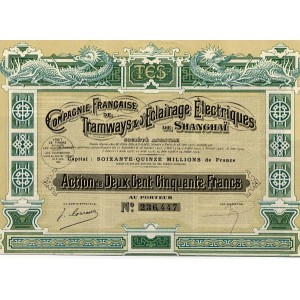
Posted: October 27th, 2015 | No Comments »
Apologies for a little self-promotion but I occasionally write articles with an Asia angle for Real Crime magazine and this month’s issue has one, by me, on the Shanghai Green Gang, Du Yuesheng and his infamous dinner party where everyone (except him) got poisoned…out now and in newsagents all over the place….

Posted: October 26th, 2015 | No Comments »
The story of August Engelhardt, the Cocovores and his mysterious death in German New Guinea in 1919 seems to be grabbing the imagination at the moment. Last year we had Adrian McKinty’s The Sun is God and now Christian Kracht’s Imperium….grab a coconut and have a read….
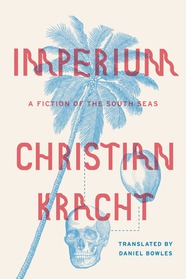 An outrageous, fantastical, uncategorizable novel of obsession, adventure, and coconuts In 1902, a radical vegetarian and nudist from Nuremberg named August Engelhardt set sail for what was then called the Bismarck Archipelago, in German New Guinea. His destination: the island Kabakon. His goal: to establish a colony based on worship of the sun and coconuts. His malnourished body was found on the beach on Kabakon in 1919; he was forty-three years old. Christian Kracht’s “Imperium” uses the outlandish details of Engelhardt’s life to craft a fable about the allure of extremism and its fundamental foolishness. Engelhardt is at once a pitiable, misunderstood outsider and a rigid ideologue, and his misguided notions of purity and his spiral into madness presage the horrors of the mid-twentieth century. Playing with the tropes of classic adventure tales such as “Treasure Island” and “Robinson Crusoe,” Kracht’s novel, an international bestseller, is funny, bizarre, shocking, and poignant. His allusions are misleading, his historical time line is twisted, his narrator is unreliable–and the result is a novel that is a cabinet of mirrors, a maze pitted with trapdoors. Both a provocative satire and a serious meditation on the fragility and audacity of human activity, “Imperium” is impossible to categorize and utterly unlike anything you’ve read before.
An outrageous, fantastical, uncategorizable novel of obsession, adventure, and coconuts In 1902, a radical vegetarian and nudist from Nuremberg named August Engelhardt set sail for what was then called the Bismarck Archipelago, in German New Guinea. His destination: the island Kabakon. His goal: to establish a colony based on worship of the sun and coconuts. His malnourished body was found on the beach on Kabakon in 1919; he was forty-three years old. Christian Kracht’s “Imperium” uses the outlandish details of Engelhardt’s life to craft a fable about the allure of extremism and its fundamental foolishness. Engelhardt is at once a pitiable, misunderstood outsider and a rigid ideologue, and his misguided notions of purity and his spiral into madness presage the horrors of the mid-twentieth century. Playing with the tropes of classic adventure tales such as “Treasure Island” and “Robinson Crusoe,” Kracht’s novel, an international bestseller, is funny, bizarre, shocking, and poignant. His allusions are misleading, his historical time line is twisted, his narrator is unreliable–and the result is a novel that is a cabinet of mirrors, a maze pitted with trapdoors. Both a provocative satire and a serious meditation on the fragility and audacity of human activity, “Imperium” is impossible to categorize and utterly unlike anything you’ve read before.
Posted: October 25th, 2015 | No Comments »
Just as Hitler did a whistle stop one day tour to occupied Paris so, on 14 March 1943, General Tojo, the Japanese Prime Minister visited Shanghai – a Shanghai occupied by the Japanese (except the French Concession which was under the control of the Vichyite collabos still). He apparently conferred with the Japanese commanders of the city and pledged that the foreign concessions would be returned to China – by which he meant to the Wang Ching-wei collaborationist puppet regime. He stayed only one day and then moved on to Nanking.
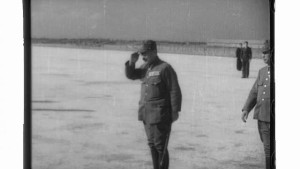
Tojo upon arrival
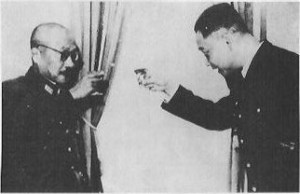 Tojo and Wang Ching-wei
Tojo and Wang Ching-wei
Posted: October 24th, 2015 | No Comments »
A tantalizingly brief article on trouble in the Peking Badlands from May 1936. Problems began when a Japanese army officer was discovered dead outside a cabaret. Of course the Chinese were worried that the Japanese would use this as an excuse to stage an “incident” as a prelude to attacking the city – they did in July 1937 at the Marco Polo Bridge. Clearly more likely that the Manchukuo Army officer was down on leave from Manchuria and decided to sample the nightlife at some newly opened joint and got himself stabbed…who knows?
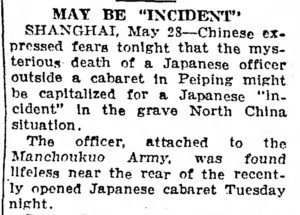
Posted: October 23rd, 2015 | No Comments »
Hsi-Sheng Ch’i’s The Much Troubled Alliance is a steep price, but if you’ve got a nice library that might solve the problem….It’s a well-trod subject but the author claims to have examined Chinese documents on the relationship not previously used much….
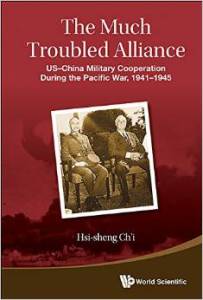 The topics of World War II and US-China relationship have been of much interest to academics and general public alike. This book challenges the conventional wisdom that has been produced on the topics over the past 50 years and offers the readers a new and balanced treatment of the topics. The scope of this book covers all the major political-military events from the Pearl Harbor attack in December 1941 to the victory over Japan in August 1945.The scholarship in this subject area has long suffered from one serious flaw, i.e., unbalanced treatment. Although the leading works in the English language have aspired to conform to high professional standards, their intrinsic limitation is that they have only consulted English language materials, but have virtually failed to consult Chinese language materials. This phenomenon is unsatisfactory since wartime US-China alliance was a highly complicated “bilateral” relationship which can only be adequately narrated and analyzed by taking into account both countries’ data and perspectives. This book addresses this glaring deficiency by employing a large amount of original Chinese source materials, but also by discovering a considerable amount of new English language materials as well as subjecting other often-used English materials to a close scrutiny.This book enables the readers to take a completely fresh look at that important period of US-China relations.
The topics of World War II and US-China relationship have been of much interest to academics and general public alike. This book challenges the conventional wisdom that has been produced on the topics over the past 50 years and offers the readers a new and balanced treatment of the topics. The scope of this book covers all the major political-military events from the Pearl Harbor attack in December 1941 to the victory over Japan in August 1945.The scholarship in this subject area has long suffered from one serious flaw, i.e., unbalanced treatment. Although the leading works in the English language have aspired to conform to high professional standards, their intrinsic limitation is that they have only consulted English language materials, but have virtually failed to consult Chinese language materials. This phenomenon is unsatisfactory since wartime US-China alliance was a highly complicated “bilateral” relationship which can only be adequately narrated and analyzed by taking into account both countries’ data and perspectives. This book addresses this glaring deficiency by employing a large amount of original Chinese source materials, but also by discovering a considerable amount of new English language materials as well as subjecting other often-used English materials to a close scrutiny.This book enables the readers to take a completely fresh look at that important period of US-China relations.
Posted: October 23rd, 2015 | 4 Comments »
The local book club of Denison, Texas chose Crow’s 400 Million Customers as its book choice for April 1947 (Carl was sadly deceased for 2 years by then). An interesting group we can assume as John Clift had been editor and written the “Yank About China” column for Stars and Stripes (the US Army newspaper) from Shanghai for several years before returning to America and his White Russian wife, Kyra Kuprianovitch Clift (born in Harbin in 1923 and her obituary here) worked for Time-Life in Shanghai – Time-Life and Stars & Stripes shared the same office in Shanghai after WW2 and, I believe, there was a company car shared by the Stars and Stripes Editor and the Time-Life correspondents …The Stars and Stripes was available in Shanghai from a newsstand by the Customs Jetty, every day except Sundays. I think (though it moved around a bit) that the office was at No.17 Bund, the offices of the North-China Daily News but also where many other publications were headquartered. It must have been a fascinating discussion….
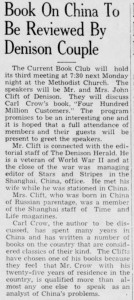
Posted: October 22nd, 2015 | 4 Comments »
The A.B. (Abe) Marcus Show was once a well known “Ziegfeld-like” touring company of showgirls (mostly American and British) that played around the world on long and grueling tours taking American burlesque and vaudeville global. Their Far East tours took in China, as well as destinations as disparate as Japan, Fiji, the Straits Settlements, Singapore, the Philippines, Hong Kong, Java, Borneo, India, New Zealand and Australia before heading to South Africa, up to the West Indies, and then across the United States and Hawaii. Legend has it that Abe Marcus was a New England dry cleaner who got stuck with a load of theatre costumes nobody ever came to collect so decided to start his vaudeville show. Their shows took inspiration (loosely – both in style and clothing) from all these places. They also recruited dancers in all the locations too – by the time they got to America in 1936 the show boasted several “Soo-chow Gals”. They were always running close to politics wherever they went – they were banned from landing in Japan in 1939, being considered too much of a display of “Occidental culture” for the authorities in Tokyo and Osaka. Their shows were invariably sell-outs, themed around “L’Orient”, “La Vie Paris” and the like but always with the headline “GIRLS, GIRLS, GIRLS“. The traveling company was usually composed of seventy-five people, and played two, two and a half hour performances per day. A few later stars, notably Danny Kaye and Fat Jack Leonard, started out with the Marcus troupe.
In 1936 the Abe Marcus show “La Vie Paris” hit Shanghai – sadly I’m not sure where it played – but it was a sell out. But there’s always one curmudgeon. And this time it was the German Consul in Shanghai, the rather dour Hermann Kriebel, who complained. It seems one of the Marcus showgirls came out on stage in a rather militaristic helmet the committed Nazi took offense to. It was slightly odd that Kriebel should object to militarism as he was one of the first members of the Nazi Party, had participated in the 1923 Munich Beer Hall Putsch and was a German delegate at the peace negotiations in Paris in 1919 where his infamous parting shot to the press was “see you in 20 years time!” It seems things also got a bit touchy in Hong Kong (though this was somewhat later on a tour in 1939) when a clown appeared on stage with an umbrella – to anyone who’d ever seen a newsreel an umbrella and a British accent meant that old appeaser Neville Chamberlain.
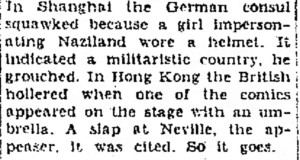
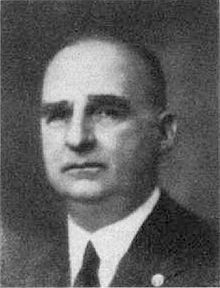
Hermann Kriebel – confirmed Nazi and German Consul to Shanghai
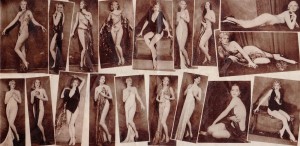
The Abe Marcus girls line up…












